Under Construction 
Causes | Prevention | Treatment | Products | Links

A bunion (Hallux Valgus) is a deformity of the metatarsophalangeal (MTP) joint at the base of the big toe. A bunion develops when the first metatarsal bone of the foot turns outward and the big toe points inward (toward the other toes), causing the joint to jut out
Eventually, the bursa (a fluid-filled sac that surrounds and cushions the joint) becomes inflamed, and the entire joint becomes stiff and painful
Causes:
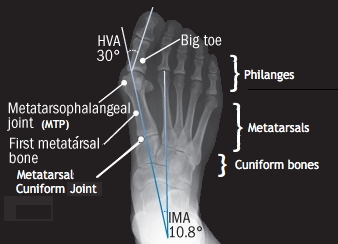 Shoes with narrow toes can trigger a bunion, but they're not the underlying cause. Bunions run in families, because foot type (shape and structure) is hereditary, and some types are more prone to bunions than others.
Low arches, flat feet, and loose joints and tendons all increase the risk. The shape of the metatarsal head (the top of the first metatarsal bone) also makes a difference:
if it's too round, the joint is less stable and more likely to deform when squeezed into shoes with narrow toes.
Shoes with narrow toes can trigger a bunion, but they're not the underlying cause. Bunions run in families, because foot type (shape and structure) is hereditary, and some types are more prone to bunions than others.
Low arches, flat feet, and loose joints and tendons all increase the risk. The shape of the metatarsal head (the top of the first metatarsal bone) also makes a difference:
if it's too round, the joint is less stable and more likely to deform when squeezed into shoes with narrow toes.
High heels can exacerbate the problem because they tip the body's weight forward, forcing the toes into the front of the shoe. This may help to explain why bunions are 10 times more common in women than in men.
Hallux Valgus angle (HVA) >15° or Intermetatarsal angle (IMA)
>9° indicate Hallux Valgus.
Source: What to do about bunions - Harvard Health
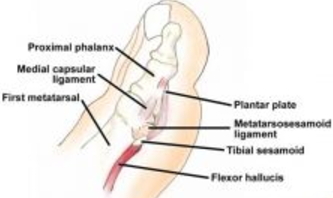
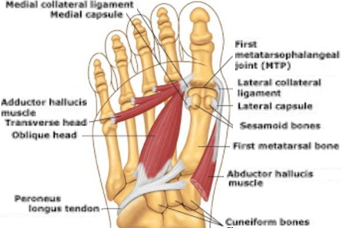 Treatment:
Treatment:
Surgery:
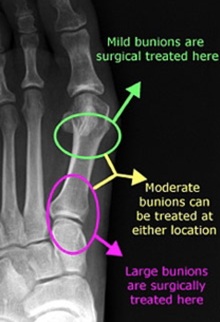
 - Bunionectomy or Exostectomy -
Shaves the bony excess on the outside of
the metatarsal head.
Realigns the muscles, tendons, and ligaments
surrounding the joint.
May not correct the deformity that caused the bunion.
Distal metatarsal head osteotomies (the first 2 below)
are the most popular surgeries.
- Bunionectomy or Exostectomy -
Shaves the bony excess on the outside of
the metatarsal head.
Realigns the muscles, tendons, and ligaments
surrounding the joint.
May not correct the deformity that caused the bunion.
Distal metatarsal head osteotomies (the first 2 below)
are the most popular surgeries.
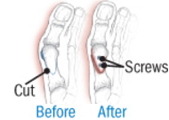 - Austin/Chevron Procedure or Long Arm Osteotomy -
Cutting (Osteotomy) of the metatarsal head to shift it into proper alignment.
The bone is held in place with screws or pins.
During this surgery, bone is removed from your toe.
Nearby tendons and ligaments are made shorter or longer as needed.
This allows your big toe to line up (align) properly.
Video
- Austin/Chevron Procedure or Long Arm Osteotomy -
Cutting (Osteotomy) of the metatarsal head to shift it into proper alignment.
The bone is held in place with screws or pins.
During this surgery, bone is removed from your toe.
Nearby tendons and ligaments are made shorter or longer as needed.
This allows your big toe to line up (align) properly.
Video
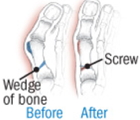 - Opening Wedge Bunionectomy - A wedge of bone is placed in the bone cut
to correct and close the abnormal angle between the 1st and 2nd metatarsals.
Donor bone graft or bone harvested from the patient can be used
for this correction.
- Keller Procedure or First MTP Joint Arthroplasty ("old lady" bunionectomy)
- Opening Wedge Bunionectomy - A wedge of bone is placed in the bone cut
to correct and close the abnormal angle between the 1st and 2nd metatarsals.
Donor bone graft or bone harvested from the patient can be used
for this correction.
- Keller Procedure or First MTP Joint Arthroplasty ("old lady" bunionectomy)
 This is the most common type of bunionectomy performed on older patients
with severe deformities and less than optimal bone stock.
Your surgeon takes the extra bone off from the side of the joint,
then makes a cut in the bone removing part of the joint.
Then a wedge of soft tissue is placed in between the pieces of bone
to alleviate bone on bone contact.
See Is the Keller Bunionectomy Outdated? | Podiatry Today
- Lapidus Bunionectomy -
This is the most common type of bunionectomy performed on older patients
with severe deformities and less than optimal bone stock.
Your surgeon takes the extra bone off from the side of the joint,
then makes a cut in the bone removing part of the joint.
Then a wedge of soft tissue is placed in between the pieces of bone
to alleviate bone on bone contact.
See Is the Keller Bunionectomy Outdated? | Podiatry Today
- Lapidus Bunionectomy -
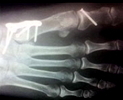 The first metatarsal-cuneiform joint is removed in a "pie wedge" manner.
This allows for the entire 1st metatarsal to shift toward the 2nd metatarsal,
in a correct position.
The lapidus bunionectomy is considered the Gold Standard for bunion surgery.
For the right patient, this procedure has the highest success rates with
essentially a 0% chance of the bunion returning.
- Mini Tightrope®
The first metatarsal-cuneiform joint is removed in a "pie wedge" manner.
This allows for the entire 1st metatarsal to shift toward the 2nd metatarsal,
in a correct position.
The lapidus bunionectomy is considered the Gold Standard for bunion surgery.
For the right patient, this procedure has the highest success rates with
essentially a 0% chance of the bunion returning.
- Mini Tightrope®
 A a less invasive procedure Holes are drilled in the first and second metatarsal
bones and a thin wire is run between them and fastened on the other side
of each bone pulling them together.
See also Dr. Charles J Sidlow, Georgia - Mini-Tightrope Bunionectomy
- Bunionplasty℠ - A technique expoused by Dr. Neal Blitz in New York.
The only things I could see that were different was less scaring with the
incision and he developed a medical implant that holds the bone steady while
healing so, he is able to allow patients to put immediate weight on the foot
right after the surgery no matter the size of the bunion.
See: Bunionplasty: A Plastic Foot Surgery Craze? | HuffPost
More at Bunion Surgeries | FootDoc.ca
A a less invasive procedure Holes are drilled in the first and second metatarsal
bones and a thin wire is run between them and fastened on the other side
of each bone pulling them together.
See also Dr. Charles J Sidlow, Georgia - Mini-Tightrope Bunionectomy
- Bunionplasty℠ - A technique expoused by Dr. Neal Blitz in New York.
The only things I could see that were different was less scaring with the
incision and he developed a medical implant that holds the bone steady while
healing so, he is able to allow patients to put immediate weight on the foot
right after the surgery no matter the size of the bunion.
See: Bunionplasty: A Plastic Foot Surgery Craze? | HuffPost
More at Bunion Surgeries | FootDoc.ca
Realigning the muscles, tendons, and ligaments can be done with any of the above.
Outcomes and complications of bunion surgery:
Source: What to do about bunions - Harvard Health
Variations among toe-joint deformities and surgical techniques make it difficult to evaluate the results of bunion surgery. Some studies suggest that 85% to 90% of patients are satisfied with their results, but one review found that about a third of patients were dissatisfied even when their pain and toe alignment improved. The problem may be unrealistic expectations.
Complication rates from various studies range from 10% to 55%. The most common complication is recurrence of the bunion, reported in as many as 16% of cases. This can happen when only the bony prominence is shaved off and the underlying deformity is not corrected.
See When Bunion Surgery Fails | Podiatry Today
Surgical complications at UK National Health Service (NHS)
- infection
- deep vein thrombosis (DVT)
- stiffness in your toe joints
- a delay or failure of the bone to heal, or the bone healing in the wrong position
- pain under the ball of your foot
- damage to the nerves in your foot
- prolonged swelling and continued pain
- the need for further surgery
- thickened scar tissue
- the bunion returning
- anesthesia issues
- complex regional pain syndrome Ð a condition that causes long-term burning pain in one of the limbs
Splints and Toe Spreaders:
Amazon.com: Bunion Corrector & Bunion Relief Protector Sleeves Kit
Rating: 4.3 out of 5, 410 reviews.
Devices such as splints and toe spreaders might make you feel better but there's no evidence that they correct alignment or prevent bunion progression (CR).
Other:
If your bunion is related to having a flat foot, prescription shoe inserts can relieve pain and slow bunion progression by supporting the arch and taking pressure off the big toe.
Get relief from bunion pain without surgery | Consumer Reports (CR)
7 Simple Tips on How to Stretch Shoes for Bunions | VBMBestReviews.Com
Running with Bunions:
Bunions will cause problems for runners. Some things to try.
Get extra wide men's shoes.
Modifying your running shoes to reduce foot bunions - YouTube
Bunion Shoe Stretcher Spot Stretching Device
Bunion & Big Toe Blisters | Fixing Your Feet Blog suggests:
- Attach an ENGO Blister Prevention Patche to the side of your shoe.
- Run a strip of tape from the inside of the big toe, around the tip and down the side past the bunion. For this, I would cut a piece of 2-inch Kinesio-Tex tape to a width that works.
Experiment with different types of tape until you find one that works. A slick and smooth tape like duct tape would be nice for this but is hard to shape to the toe.
See blisters here
Links:
Bunion Surgery | WebMD
Bones of the Foot
Bunion Surgery: The Complete Patient Guide
Types of Bunion Surgery, Lapidus Bunionectomy
What to do about bunions - Harvard Health
Osteotomy and Ligament or Tendon Repair (Bunion Surgery) | SaintLukesHealthsystem
Bunion Myths, Misconceptions, and Treatments: 10 Things You've Always Wanted to Know To Treat Your Feet - Healing Feet
Austin Bunionectomy Surgery With Screw Fixation | - YouTube
Return to Health
last updated 20 June 2017
| 